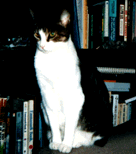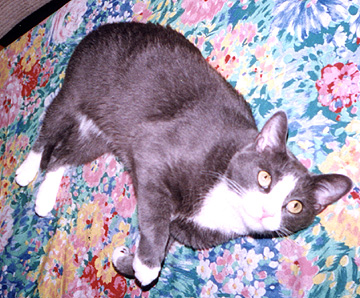|
|
 | The Power of Purr |  |
In the series, A Dragon's Guide to Destiny, cats of various sizes use purring for healing purposes. This practice is based on scientific principles. When I was first learning about crystals and vibrations, my idea of vibration was a cat's purr, and I wondered what kind of healing could be accomplished by placing a cat on each chakra. The research I did for this article suggested that this would be a very good idea. If you are owned by one or more cats, you probably already know the roles they play as healers in your life, but you may enjoy having some details and statistics: both to persuade your cat-loving but holistically-indifferent friends that there might be something to this vibration business. Those who are holistically inclined but indifferent to cats may gain a deeper appreciation of my favorite species. I've simplified the technical information so that I could understand it. I hope it works for you, too. I have been instructed to thank the cats who visited me while I was writing this and who told me what to write.
Scientists have determined that cats, including pumas, lions, tigers, ocelots, cheetahs, etc., usually purr in the range of 20 to 140 Hertz (Hz). (1 Hertz means a vibrating structure moves back and forth once per second. A domestic cat usually purrs at a frequency of 25 and 50 Hz. This is important because: Research has demonstrated that exposure to a frequency of 25 Hz increases bone density by at least 20%. Veterinarians, who've known this for a long time, say that if you put a cat and some broken bones in the same room, the bones will heal. This may also explain why cats rarely suffer bone or joint related diseases, including hip dysplasia, arthritis and ligament problems, or bone cancers. Not only bones are affected by purring. Other research has demonstrated that, in the higher frequency ranges, the body produces an increase of natural anti-inflammatory compounds. This reduces joint pain and swelling and results in the healing of muscles, tendons, and ligaments. Purring also seems to open up a cat's air passages, thus reducing the incidence of respiratory problems. The respiratory difficulties often associated with heart disease are rarely found in cats, and all breathing problems a cat may have are quickly alleviated when the cat begins to purr. A story in the New Zealand Veterinary Journal (1973) described a dying cat who was having so much trouble breathing that its vet was considering euthanasia. However, once it started to purr, it began to breathe normally. Purring seemed to open its air passages. The cat's ability to change the frequency of its purring is probably one of its fine-tuning healing abilities. It may account for domestic cats living longer lives than their canine counterparts and may also have given rise to the idea that cats have nine lives. They survive conditions that normally kill other animals, such as falls from heights. In a study of 132 cat falls with an average fall height of 5 _ stories, 90% survived. The record height for a cat falling and surviving is 45 stories.
Cat fans have always believed a cat's purr was relaxing or stress reducing. Stress reduction alone can lead to countless health benefits. Many people report that lying in bed with a purring cat helps them go to sleep easily. Others have noticed that their cats seem to know when they're not feeling well and the location of the pain. Have you ever had a stomachache that was eased by a cat purring in your lap? A friend of mine who was going through a serious psychological disorder discovered that every time she was lying in bed shaking with fear, her cat would dash from the living room and curl up beside her, purring loudly. This feline nursing procedure got her through a number of rough spots. Now science is beginning to confirm what we cat lovers have always known. Studies have shown that owners, especially senior citizens, who have cats have lower blood pressure and can live longer than humans who don't own pets. Scientists are now researching whether sound and vibration therapy could halt osteoporosis, or renew bone growth in post-menopausal women and the elderly. Other StudiesPsychologist Dr. June McNicholas of Wales is a strong advocate for allowing pets to visit their people who are in hospitals. She believes that animal companionship can assist the healing process. She and some colleagues found that:
The children are smart in their choices. A study by the Institute of Paediatrics and Adolescent Medicine in Munich found that young children continuously exposed to cats were 67% less likely to develop allergic asthma. 45% were less susceptible to developing hay fever than other children. Researchers at Warwick University in the UK also found that children who own pets have stronger immune systems and take fewer days off school due to illness.
Humans are accustomed to getting a dose of pity with treatment. We expect our caretakers to say, "I'm so sorry." "Oh, I feel so badly for you." "What an awful thing happened to you." We forget that when we're vibrating in a state of feeling sorry for ourselves, feeling miserable and hurt, we aren't making ourselves feel better. A confirmation that the physical/emotional place we currently occupy is unpleasant and undesirable only serves to help keep us there. The cat sends no "Get Well Soon" cards. It doesn't sit by your bed looking sympathetic. It doesn't say "Poor thing." It gets on your lap and purrs. It doesn't look to be rewarded for its healing work. It's not thinking, "I want you to think I'm great because you feel better." And if you don't feel better, it isn't going to feel worse. This may be vibrational healing at its best. No ego is involved, and the feline healer doesn't have an investment in the outcome. It purrs because purring feels good. Rainbows don't shine for our benefit, either, but we love to see them.
A Dragon's Guide to Destiny |


